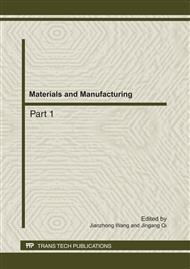p.679
p.687
p.692
p.696
p.700
p.704
p.708
p.712
p.718
Influence of Die Angle on the Extrusion Behavior of 6061Al Matrix Composite Reinforced with SnO2-Coated Aluminum Borate Whisker
Abstract:
The 6061Al matrix composites reinforced with SnO2-coated aluminum borate whisker were fabricated using squeeze casting method. The composite were extruded successfully at 350°Cwith different die angles. The experiment results illustrate that the die angle have important influences on the extrusion process. The surface quality of extruded composites was improved and the extrusion load was reduced with die angle increasing from 30 to 60 degree. The <111> and <100> textures for aluminum matrix were formed in all extruded composites. The dispersion degree of the <111> texture, the alignment degree and the average length of whiskers increases with die angle increasing. There is a suitable die angle for the optimization of the extrusion process of the present composite.
Info:
Periodical:
Pages:
700-703
Citation:
Online since:
July 2011
Authors:
Keywords:
Price:
Сopyright:
© 2011 Trans Tech Publications Ltd. All Rights Reserved
Share:
Citation:


